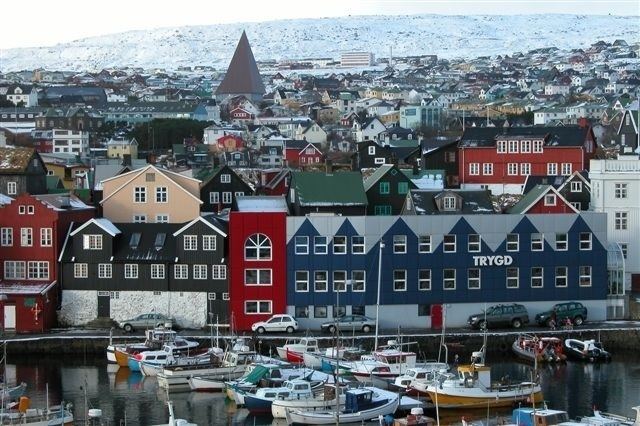Fiscal year calendar year GDP growth 7.5% (2013 est.) | Trade organisations none | |
 | ||
Currency Faroese króna (pegged with Danish krone, (DKK)) GDP $1.471 billion (2013 est.) GDP rank 166th (nominal) / 179th (PPP) | ||
The economy of the Faroe Islands was the 166th largest in the world in 2014, having a nominal gross domestic product (GDP) of $2.613 billion per annum.
Contents
High dependence on fishing means the economy remains extremely vulnerable. The Faroese hope to broaden their economic base by building new fish-processing plants. Petroleum found close to the Faroese area gives hope for deposits in the immediate area, which may lay the basis to sustained economic prosperity. Also important are the annual subsidy from Denmark, which amounts to about 3% of the GDP.
The Faroes have one of the lowest unemployment rates in Europe, but this is not necessarily a sign of a recovering economy, as many young students move to Denmark and other countries once they are finished with high school. This leaves a largely middle-aged and elderly population that may lack the skills and knowledge to take IT positions on the Faroese people.
History
After the severe economic troubles of the early 1990s, brought on by a drop in the vital fish catch and poor management of the economy, the Faroe Islands have come back in the last few years, with unemployment down to 5% in mid-1998, and holding below 3% since 2006, one of the lowest rates in Europe.
Since 2000, new information technology and business projects have been fostered in the Faroe Islands to attract new investment. The result from these projects is not yet known but is hoped to bring a better market economy to the Faroe Islands.
Trade
In 2014 the Faroe Islands had a trade surplus of 401 million DKK. The Faroe Islands mainly imported from Denmark (1,625 million DKK), Norway (1,178 DKK), and Germany (548 million DKK). The country's top export destinations were Russia (1,059 million DKK), the United Kingdom (660 million DKK), the United States (660 million DKK), and Germany (639 million DKK). European Union countries contributed 62.7% of Faroese imports, while the exports of the Faroes Islands were almost equally distributed between European Union (49.8%) and non-European Union coutries (50.2%). The vast majority of Faroese exports, almost 95%, consists of fishery products. Russian countersanctions on food imports from Norway and the European Union, saw the Faroe Islands increase its fresh salmon exports to Russia.
Energy
In 2014 217,547 tonnes of oil products were consumed in the Faroe Islands. Of this 31.58% was consumed by fishing vessels, 14.73% was used by SEV for electricity production, 23.23% was consumed in air, sea or land transport, 9.6 was used in the industry, and the rest was used in public or private buildings.
The islands have 6 hydroelectric plants, 4 diesel plants and several wind power plants with a capacity factor above 40%. In 2014, a 12MW wind farm for DKK 180 million became operational near Torshavn and increased wind capacity from 6.6 to 18.6MW. It decreases oil consumption by 8,000 ton (approximately 4M€) per year. A 2.3MW 700 kWh lithium-ion battery became operational in 2016. Planners also consider converting the existing hydropower to pumped-storage hydroelectricity. Tidal power and Thermal energy storage solutions are also considered. The islands have a goal of 100% green electricity production by 2030.
In 2014 50.8% of the electricity production of SEV in the Faroe Islands came from green energy like hydro and wind, while 49.2% was produced by the thermal power plants, which was 12.4% less than in 2013.
Total annual production: 305.4 GWh (2014) of which the production of thermal, hydropower and wind power was:
The Faroe Islands have no electricity connections to other areas, and thus operate in island condition. Some islands are also not connected to the other islands, and must maintain their own electric system.
Other
Agriculture - products: milk, potatoes, vegetables; sheep; salmon, other fish
Currency: 1 Danish krone (DKr) = 100 ører
Exchange rates: Danish kroner (DKr) per US$1 – 5.560 (2008), 7.336 (January 2000), 6.976 (1999), 6.701 (1998), 6.604 (1997), 5.799 (1996), 5.602 (1995)
